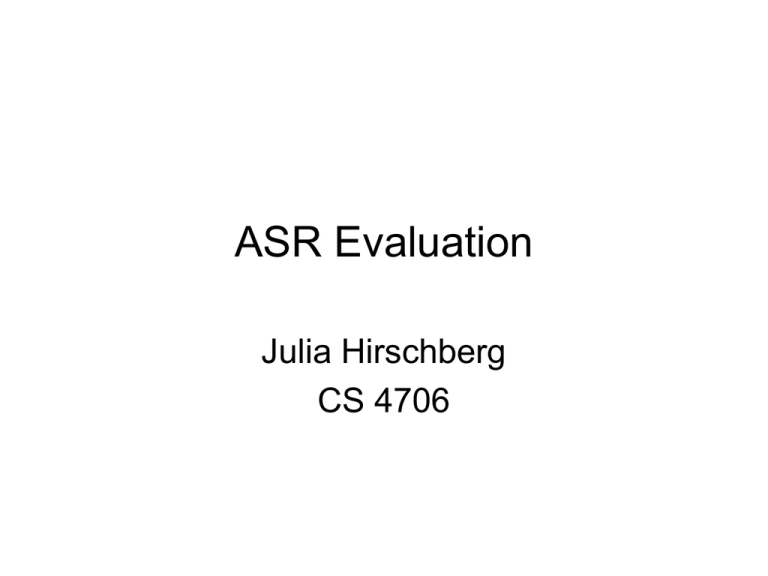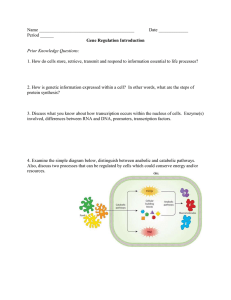ASR Evaluation Julia Hirschberg CS 4706
advertisement

ASR Evaluation Julia Hirschberg CS 4706 Outline • Intrinsic Methods – Transcription Accuracy • • • Word Error Rate Automatic methods, toolkits Limitations – Concept Accuracy • • Limitations Extrinsic Methods Evaluation • How to evaluate the ‘goodness’ of a word string output by a speech recognizer? • Terms: – 7/15/2016 Speech and Language Processing Jurafsky and Martin 3 Evaluation • How to evaluate the ‘goodness’ of a word string output by a speech recognizer? • Terms: – ASR hypothesis: ASR output – Reference transcription: ground truth – what was actually said Transcription Accuracy • Word Error Rate (WER) – Minimum Edit Distance: Distance in words between the ASR hypothesis and the reference transcription • Edit Distance: = (Substitutions+Insertions+Deletions)/N • For ASR, usually all weighted equally but different weights can be used to minimize difference types of errors – WER = Edit Distance * 100 WER Calculation • Word Error Rate = 100 (Insertions+Substitutions + Deletions) -----------------------------Total Word in Correct Transcript Alignment example: REF: portable **** PHONE UPSTAIRS last night so HYP: portable FORM OF STORES last night so Eval I S S WER = 100 (1+2+0)/6 = 50% 7/15/2016 Speech and Language Processing Jurafsky and Martin 6 • Word Error Rate = 100 (Insertions+Substitutions + Deletions) -----------------------------Total Word in Correct Transcript Alignment example: REF: portable **** phone upstairs last night so *** HYP: preferable form of stores next light so far Eval S I S S S S I WER = 100 (1+5+1)/6 = 117% NIST sctk-1.3 scoring softare: Computing WER with sclite • http://www.nist.gov/speech/tools/ • Sclite aligns a hypothesized text (HYP) (from the recognizer) with a correct or reference text (REF) (human transcribed) id: (2347-b-013) Scores: (#C #S #D #I) 9 3 1 2 REF: was an engineer SO I i was always with **** **** MEN UM and they HYP: was an engineer ** AND i was always with THEM THEY ALL THAT and they Eval: D S I I S S 7/15/2016 Speech and Language Processing Jurafsky and Martin 8 Sclite output for error analysis CONFUSION PAIRS 1: 2: 3: 4: 5: 6: 7: 8: 9: 10: 11: 12: 13: 14: 15: 16: 7/15/2016 6 6 5 4 4 4 4 3 3 3 3 3 3 3 3 3 -> -> -> -> -> -> -> -> -> -> -> -> -> -> -> -> Total With >= (%hesitation) ==> on the ==> that but ==> that a ==> the four ==> for in ==> and there ==> that (%hesitation) ==> and (%hesitation) ==> the (a-) ==> i and ==> i and ==> in are ==> there as ==> is have ==> that is ==> this (972) 1 occurances (972) Speech and Language Processing Jurafsky and Martin 9 Sclite output for error analysis 17: 18: 19: 20: 21: 22: 23: 24: 25: 26: 27: 28: 29: 30: 31: 32: 33: 34: 7/15/2016 3 -> it ==> that 3 -> mouse ==> most 3 -> was ==> is 3 -> was ==> this 3 -> you ==> we 2 -> (%hesitation) ==> 2 -> (%hesitation) ==> 2 -> (%hesitation) ==> 2 -> (%hesitation) ==> 2 -> a ==> all 2 -> a ==> know 2 -> a ==> you 2 -> along ==> well 2 -> and ==> it 2 -> and ==> we 2 -> and ==> you 2 -> are ==> i 2 -> are ==> were it that to yeah Speech and Language Processing Jurafsky and Martin 10 Other Types of Error Analysis • What speakers are most often misrecognized (Doddington ’98) – Sheep: speakers who are easily recognized – Goats: speakers who are really hard to recognize – Lambs: speakers who are easily impersonated – Wolves: speakers who are good at impersonating others • What (context-dependent) phones are least well recognized? – Can we predict this? • What words are most confusable (confusability matrix)? – Can we predict this? Are there better metrics than WER? • WER useful to compute transcription accuracy • But should we be more concerned with meaning (“semantic error rate”)? – Good idea, but hard to agree on approach – Applied mostly in spoken dialogue systems, where semantics desired is clear – What ASR applications will be different? • Speech-to-speech translation? • Medical dictation systems? 7/15/2016 Speech and Language Processing Jurafsky and Martin 13 Concept Accuracy • Spoken Dialogue Systems often based on recognition of Domain Concepts • Input: I want to go to Boston from Baltimore on September 29. • Goal: Maximize concept accuracy (total number of domain concepts in reference transcription of user input) Concept Value Source City Baltimore Target City Boston Travel Date Sept. 29 – CA Score: How many domain concepts were correctly recognized of total N mentioned in reference transcription Reference: I want to go from Boston to Baltimore on September 29 Hypothesis: Go from Boston to Baltimore on December 29 • 2 concepts correctly recognized/3 concepts in ref transcription * 100 = 66% Concept Accuracy – What is the WER? • 3 Ins+2 Subst+0Del/11 * 100 = 45% WER (55% Word Accuracy) Sentence Error Rate • Percentage of sentences with at least one error – Transcription error – Concept error Which Metric is Better? • Transcription accuracy? • Semantic accuracy? Next Class • Human speech perception

